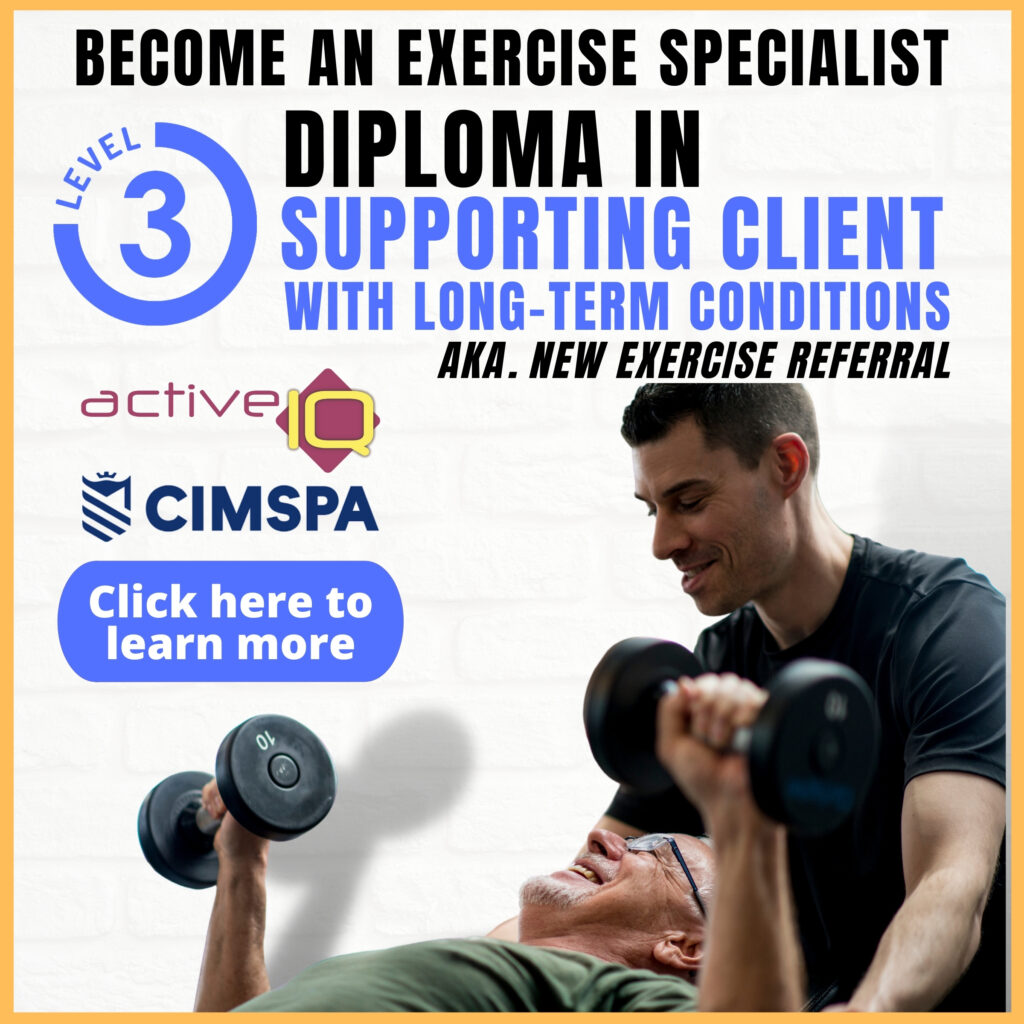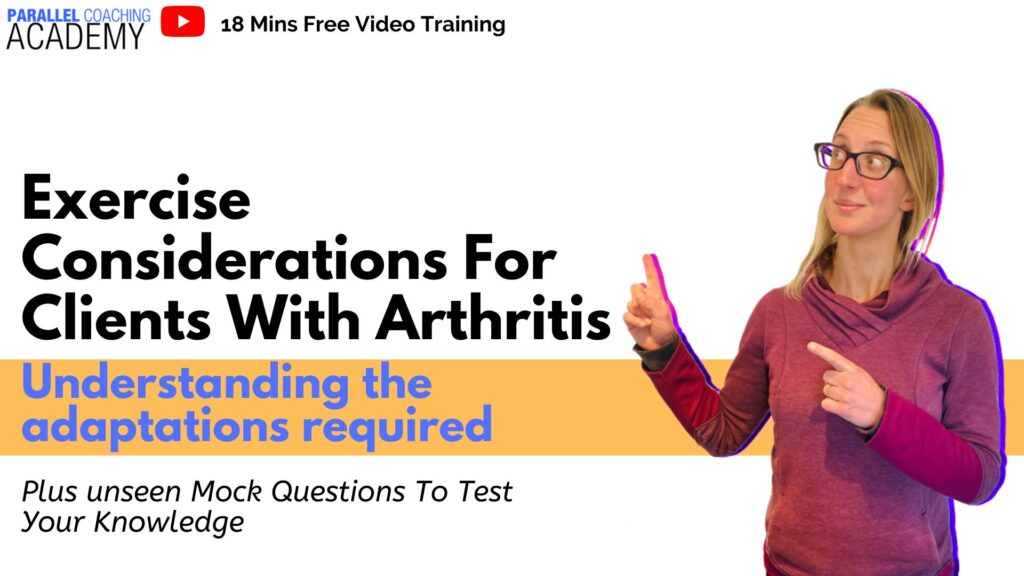As a Fitness Professional, you need to understand the exercise considerations for clients with Arthritis, and the qualifications required to work with them effectively.
Today’s blog will explore arthritis, who can work with clients with musculoskeletal conditions, exercise guidelines and exercise considerations for arthritis.
At the bottom of this blog, you’ll also find three mock questions to test your knowledge
Watch: Exercise Considerations Clients With Arthritis
What is Arthritis?
Arthritis is not a single condition, but a term used to describe
over 100 conditions that affect the joints of the body.
All have common symptoms such as pain, inflammation, and swelling that typically lead to stiffness and restricted mobility.
What is Osteoarthritis (OA)?
The most prevalent form of arthritis is osteoarthritis. This is related to wear and tear of the joints and is more prevalent in older adults than in any other age group.
Osteoarthritis is characterised by the local degeneration of weight-bearing joints, typically those of the knees, hips, spine, and hands.
Age is the largest determining factor in the development of osteoarthritis; with obesity, genetic predisposition, and injury also contributing to the risk.
What is Rheumatoid Arthritis (RA)?
Rheumatoid arthritis (RA) is another common form. It is an autoimmune condition in which the synovial tissues are inflamed and swollen.
RA is usually widespread throughout the body and often affects smaller joints in the hands, wrists, and feet before being noticed in larger joints like the cervical spine and knees.
People with inflammatory conditions go through periods where symptoms are less and periods of ‘flare-ups’.
Avoiding morning physical activity during flare-ups is key as joints are generally more stiff earlier in the day. It may be that exercise is ceased during extreme flare-ups as it can cause serious tissue damage.
Who can work with clients who have Arthritis?
Not all fitness professionals can work with all clients. Knowledge and understanding of musculoskeletal conditions is not explored in the foundational qualifications of Level 2 gym, Level 3 Personal Trainer, Level 3 Pilates or Level 3 Yoga.
Therefore, if you want to work with clients that have a long-term condition, you will need to have a specialist qualification that teaches you how to adapt exercise to the complex needs of these clients.
These specialist qualifications include the Diploma in Exercise Referral or the New Level 3 Diploma in Supporting Clients With Long-Term Conditions.
This qualification teaches you all of the considerations and contraindications for working with arthritis and you learn how to manage 27 other clinical conditions. These other conditions often exist alongside musculoskeletal conditions as comorbidities, they include obesity, osteoporosis, mental health, diabetes, hypertension and back pain, amongst many more.
Exercise Guidelines for Health
There are exercise guidelines that aim to promote health and reduce the occurrence of clinical conditions. As a FITPRO we should promote clients to meet the minimum of these exercise guidelines. However, your client cannot go from doing zero exercise in week 1, to meeting the guidelines in week 2. You will need to create incremental goals and programme gradual progression that is sustainable.
The guidelines are:
- 150 mins of moderate activity every week (can be split into 10 -30 minute chunks)
- 2 sessions of resistance training per week
- Include flexibility and coordination exercises 5-7 times per week
Exercise Considerations for Clients with Arthritis
Even when fully qualified there are specific exercise considerations that need to be adhered to when working with arthritis. These exercise guidelines manage the safety of the client and mitigate the risk of client injury, pain, and deterioration of the condition, and its symptoms.
- Encourage health-related activity guidelines
- Consider the Range Of Movement, and adapt exercises to within comfortable ranges
- Become aware of postural compensations and mal-alignment, then choose appropriate regressed exercises to correct the alignment and encourage safe exercise.
- Avoid impact exercises that cause additional pressure on joints.
- You may need a longer warm-up, including controlled mobility, especially around the affected joints, to lubricate the synovial joints. It is also beneficial to take a longer cardiovascular pulse raise during the warm-up to make sure there is plenty of heat in the joints.
- Avoid excessive repetition on the affected joints. For example, lots of running or cycling may be too much volume on an already damaged knee joint, but some of this is fine. Use a variety of exercises to limit excessive repetition.
- Focus on fall prevention, by activating the core and glutes. Improve overall Agility, Balance, and Coordination.
- Consider client pain levels. You may use a 1-10 pain scale in your session, alongside a 1-10 RPE scale, so you can gauge that the client is not moving through pain.
- Allow plenty of recovery between exercise sessions, especially with auto-immune conditions like Rheumatoid Arthritis.
- Be mindful of individual progress and pain fluctuations by asking key questions before and in between sessions. Discuss symptoms, pain, and flare-ups and gain an insight into their current status.
- Also, factor in other conditions (that will also have a list of considerations) and consider all medications and side effects.
Considering Supercompensation and Arthritis
The concept of super-compensation explains the acute, short-term response to exercise. This concept should also be considered when planning periodised progressive programmes. Supercompensation can be described as the process that the body goes through in order to progress from workout to workout.
There are four phases of super-compensation.
- Phase 1: This phase lasts 1-2 hours post-workout and is characterised by fatigue.
- Phase 2: This phase lasts 1-2 days post-workout and is when the physiological recovery and repair takes place. Delayed onset muscle soreness (DOMS) might be experienced.
- Phase 3: This phase lasts 1-3 days and is when super-compensation occurs and the body adapts to a higher level.
- Phase 4: This phase lasts 3-7 days. If no further stimulus has been applied, any progressions made during the super-compensation phase (phase 3) is gradually lost.
it is vital to consider the
To summarise:
- Arthritis is not just ONE condition
- Symptoms are different for each client
- Make sure you are qualified to work with clients that have conditions
- Adapt exercise to avoid PAIN, and allow for MORE recovery
- Write a comment below sharing what you’ve learned today
There are a lot of exercise considerations for clients with Arthritis. Without a proper understanding of these considerations, it is easy to cause unintentional harm to the client, putting them at risk of injury and worsening their condition and symptoms
It is important to be adequately qualified to work with the clients you want to work with and carefully plan for their individual needs. If you want to specialise in working with clients that have conditions check the link below to find out more.
Test your knowledge with three mock questions:
[NOTE: The answers are below the 3rd question]
Q1: Which of the following is a description of Osteoarthritis ?
A. Pain and Injury to a joint
B. An autoimmune condition in which the synovial tissues are inflamed and swollen
C. Local degeneration of weight-bearing joints
D. Lower than average bone density
Q2: Which is NOT considered an exercise guideline for healthy living?
A. 150 mins of moderate activity per week
B. 20 minutes of vigorous CV training per week
C. 2 resistance training sessions per week
D. Regular flexibility and coordination work
Q3: Which qualification is required to work with Arthritic clients?
A. Level 3 Personal Trainer
B. Level 2 Indoor Cycling
C. Level 3 Yoga
D. L3 Diploma in Supporting Clients with Long Term Conditions
Answers to the mock questions are :
Question 1= C, Question 2 = B, Question 3 = D
If you want more mock questions like this, then you can download more Free Mock Questions: DOWNLOAD NOW
Want to become a specialist and train clients with Long Term Conditions?
Become a specialist in offering health-related activity advice and supporting clients who fail a PAR-Q or have Long-Term Conditions.
This is your opportunity to set yourself apart from other FITPROs, expand your knowledge, and confidence, and link up with healthcare professionals.

Dedicated to More
Hayley “Exercise Considerations For Clients With Arthritis” Bergman
Parallel Coaching
P.S. You can also find us on the following platforms:
Instagram: Follow Now
Facebook: Like Our Page
Twitter: Tweet Us
YouTube: Subscribe Here
More Long-Term Conditions Blogs: HERE

